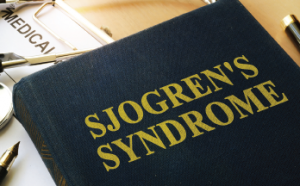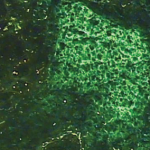
designer491 / shutterstock.com
Physicians already know a great deal about Sjögren’s syndrome’s symptoms and potential complications, and a new study confirms data on two long-suspected predictors of progression (i.e., measurable phenotypic findings) that could show which patients are likely to progress to active disease: hypergammaglobulinemia and hypocomplementemia.
Published in the February issue of Arthritis Care & Research, “Natural History and Predictors of Progression to Sjögren’s Syndrome Among Participants of the Sjögren’s International Collaborative Clinical Alliance Registry” (SICCA) looked at data from 771 patients at both baseline and a follow-up visit after two to three years.1 The study analyzed various data “to explore changes in the phenotypic features (serologic, oral and ocular) of Sjögren’s syndrome, and in Sjögren’s syndrome status among participants” over this two- to three-year interval, the paper says.
Sjögren’s syndrome (SS) is a systemic autoimmune disease that affects anywhere from two to 10 in 10,000 people, according to one U.S. population-based cohort study published in 2016.2 SS typically progresses slowly, and patients experience often debilitating loss of function in their moisture-producing glands, including the salivary and lacrimal glands. In SS, mononuclear lymphoid cells infiltrate these organs and gradually replace epithelial tissue. Various chemokines and cytokines are involved in this process, and B cell activating factor may play a particularly strong role. Research is underway to identify new genetic and molecular markers in SS to improve diagnosis and lead to the development of new, more effective therapies.3
Progression to Disease
SICCA, funded by the National Institute of Dental and Craniofacial Research (NIDCR) of the National Institutes of Health, was launched by a global group of clinical and laboratory investigators in 2003. SICCA’s main goal was to establish an international biorepository of samples and a registry of patients with signs and symptoms of SS or those who have received a diagnosis of SS. These serve as resources for scientists around the world. Another primary objective of the SICCA project was to develop new classification criteria for SS, says Caroline H. Shiboski, DDS, MPH, PhD, the Leland A. and Gladys K. Barber Distinguished Professor in Dentistry at the University of California, San Francisco.
This two-phase study included nine academically based research groups in Argentina, China, Denmark, Japan, the U.S., the United Kingdom and India, each including one or more rheumatologists, ophthalmologists and oral medicine/pathology specialists with experience diagnosing and managing SS patients.
To classify patients for inclusion in clinical trials and other studies, two sets of criteria exist. An initial set of classification criteria was provisionally approved by the ACR in 2012.4 Subsequently, a definitive set of classification criteria, the development and validation of which involved a group of SS experts both within and outside of SICCA, was approved by both the ACR and the European League Against Rheumatism (EULAR) in 2016.5 Both sets were used to define SS in the present study, which explores changes over time with respect to phenotypic features of SS and to SS status.
‘While some progress has occurred over time, there can still be a lot of delay in the initial diagnosis.’ —Dr. Shiboski
Study Methods & Results
The SICCA researchers explored changes in phenotypic features of SS over a two- to three-year period. All participants were part of the SICCA registry and had objective measures of salivary hypofunction, dry eye, focal lymphocytic sialadenitis in a minor salivary gland biopsy, or anti-SSA/Ro or anti-SSB/La antibodies.
Out of 3,514 patients enrolled in the SICCA registry by September 2013, 3,310 eligible patients were identified, and 771 of these presented for follow-up. Among patients who were found to have SS according to the 2012 ACR classification criteria at baseline, 93% also met these criteria at follow-up, and 89% met the 2016 ACR/EULAR criteria at follow-up. Among the patients who did not meet either criteria set at baseline, 9% progressed to meet the ACR criteria at follow-up, and 8% met the ACR/EULAR criteria at follow-up.
At the study entry, patients with hypergammaglobulinemia (defined as immunoglobulin G [IgG] >1,445 mg/dL at study entry) were four times more likely to progress to SS, and those with hypocomplementemia (defined as C4 <16 mg/dL at study entry) were six times more likely to progress to SS, both according to the ACR criteria. Both factors were predictive of progression to active disease, the study’s co-authors concluded.
When using the ACR/EULAR criteria to measure progression, hypergammaglobulinemia was still a strong predictor, but hypocomplementemia was not statistically significant.
Another interesting finding: Overall lymphoma incidence among the patients was very low.
Short Follow-Up
SICCA’s original contract funded the progression study over five years, so the researchers initially decided to follow up with their participants at two years after study entry, which “explains why there was such a short follow-up period for this study,” says Dr. Shiboski. Progression to active disease can take a long time, she adds, so ideally they should have performed the follow-up visits after 5–10 years. The group subsequently received a five-year extension, but by then it was too late to modify the study design to lengthen the initial follow-up period.
“Although some progress has occurred over time, there can still be a lot of delay in the initial diagnosis,” says Dr. Shiboski. Growing awareness may shorten the time to diagnosis, and better defined ACR/EULAR-endorsed classification criteria used in large clinical trials may spur the development of more effective therapies for SS, she adds.
Antibiotic prophylaxis with TMP/SMX was used in 73 of 192 patients. Its use was associated with reduced risk of infections, according to the investigators.
Clarifying the Picture
Diagnostic delays may lead to patients developing serious clinical outcomes, such as tooth decay, tooth erosions or oral infections stemming from dry mouth.6 SS patients may be comanaged by a multidisciplinary team that includes a dentist, ophthalmologist and rheumatologist, as well as the patient’s primary care physician. It’s important to encourage any patient with possible SS to get an early diagnosis, because hypergammaglobulinemia and hypocomplementemia have been shown in past studies to be associated with higher morbidity in these patients, says Dr. Shiboski. Rheumatologists use antibody tests for anti-SSA(Ro) to identify patients with SS, she says, “but patients who are not positive for that antibody may still have SS, and high IgG or low complement could be useful for rheumatologists as earlier predictors of SS.”
Other studies have shown that patients with hypergammaglobulinemia and hypocomplementemia have a higher rate of developing lymphomas, so continued monitoring of these serologic markers after diagnosis of SS is also important. “In the future, hopefully new biomarkers will be identified that will facilitate and accelerate the diagnosis of SS, and future classification will likely rely on such biomarkers,” says Dr. Shiboski.
Susan Bernstein is a freelance medical journalist based in Atlanta.
References
- Shiboski CH, Baer AN, Shiboski SC, et al. Natural history and predictors of progression to Sjögren’s syndrome among participants of the Sjögren’s International Collaborative Clinical Alliance Registry. Arthritis Care Res (Hoboken). 2018 Feb;70(2):284–294.
- Maciel G, Crowson CS, Matteson EL, et al. Prevalence of primary Sjögren’s syndrome in a U.S. population-based cohort. Arthritis Care Res (Hoboken). 2017 Oct;69(10):1612–1616.
- Jonsson R, Bolstad AI, Brokstad KA, et al. Sjögren’s syndrome—a plethora of clinical and immunological phenotypes with a complex genetic background. Ann NY Acad Sci. 2007 Jun;1108:433–447.
- Shiboski SC, Shiboski CH, Criswell L, et al. American College of Rheumatology classification criteria for Sjögren’s syndrome: A data-driven, expert consensus approach in the Sjögren’s International Collaborative Clinical Alliance cohort. Arthritis Care Res (Hoboken). 2012 Apr;64(4):475–487.
- Shiboski CH, Shiboski SC, Seror R, et al. 2016 American College of Rheumatology/European League Against Rheumatism Classification Criteria for Primary Sjögren’s syndrome: A consensus and data-driven methodology involving three international cohorts. Arthritis Rheumatol. 2017 Jan;69(1):35–45.
- Cartee DL, Maker S, Dalonges D, et al. Sjögren’s syndrome: Oral manifestations and treatment, a dental perspective. J Dent Hyg. 2015 Dec;89(6):365–371.

